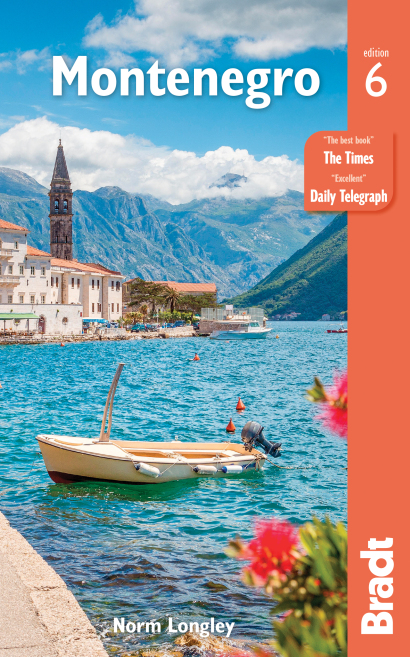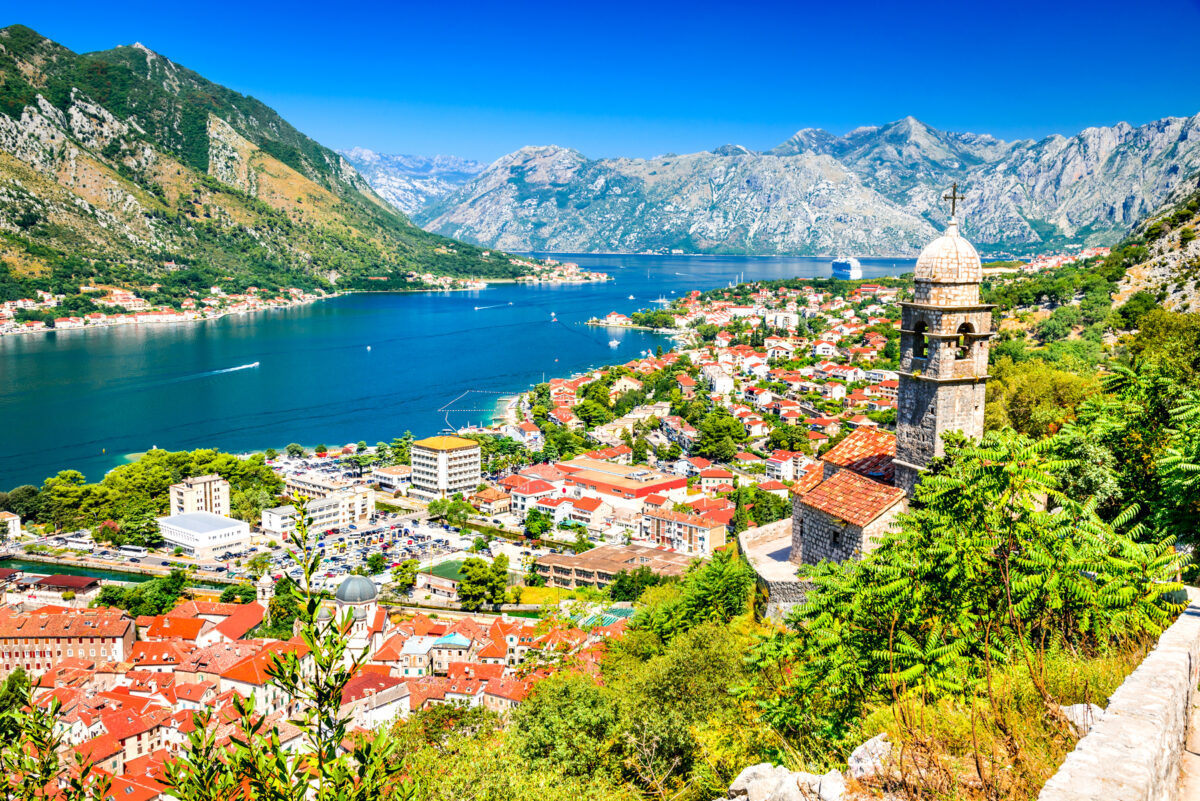The remote, often inhospitable interior of Montenegro displays an outstanding array of snow-dusted peaks, crystal-clear lakes and rivers and deep forests and canyons.
Norm Longley author of Montenegro: The Bradt Guide
Boasting one of the most dramatic stretches of coastline in all of Europe, as well as some of the continent’s wildest and most beautiful mountains, tiny Montenegro (Crna Gora, meaning ‘Black Mountain’) is likely to confound most visitors’ expectations. Nearly 300km long, its stunning Adriatic coastline is liberally sprinkled with historic towns, lively beach resorts, secluded coves and comely white-stone fishing villages, all punctuated by strips of fine sand and pebble beaches. The remote, often inhospitable interior, meanwhile, displays an outstanding array of snow-dusted peaks, crystal-clear lakes and rivers and deep forests and canyons. The whole adds up to a diverse landscape quite extraordinary for such a small country.
Yet the variety that Montenegro manifests stretches beyond its physical attributes. The country lies on one of Europe’s great historical fault lines, where the Catholic West meets Orthodox East, with Islam thrown in for good measure: it’s a heritage that imbues it with a remarkable cultural heterogeneity. Montenegro has been subject to numerous invaders and occupiers over the centuries, each of which has left an imprint of sorts.
A pre-millennium decade of conflict in the Balkans exacted quite a toll on the country. Resources were stretched to the limit and much of the infrastructure fell into disrepair, leading to a significant drop in tourist numbers, in particular an absence of visitors from western Europe and North America.
Since independence, there has been a dramatic upsurge in visitor numbers, recalling the halycon days of the 1970s and 1980s when Montenegro was one of the hottest destinations in all of Yugoslavia, attracting not only large numbers of package tourists but also celebrities and movie stars. In the last decade, investment has poured in, mainly from the Russians, who have pumped vast sums of capital into the many (far too many for some) construction projects along the coast, mainly in the form of high- end hotels, while the littoral’s popularity as a property hotspot for foreigners shows no sign of abating.
The interior, meanwhile, lags some way behind the coast in terms of its tourist infrastructure, though the potential here is immense. Indeed, an increasing number of small eco-villages are providing restful stopovers for travellers in the beautiful wilderness of the mountains, and the sublime Prokletije has been recognised as a national park, bringing the total number of parks to five.
For more information, check out our guide to Montenegro
Health and safety in Montenegro
Health
It is recommended that travellers from the UK to Montenegro be up to date on primary courses of vaccinations for diphtheria, tetanus and polio; these now come as an all-in-one vaccine (Revaxis), which lasts for ten years. Travellers should also check that they have had two doses of MMR (measles, mumps and rubella) given at least one month apart.
Other vaccines to be considered are pneumococcal and flu vaccine in the elderly, as well as hepatitis A. Hepatitis B should also be considered for longer trips and definitely for those working in medical settings or with children.
Safety
The level of crime in Montenegro is low and it is generally safe to walk in towns after dark, at least in the central areas. There is some petty theft, for instance from pockets, beach bags or unattended cars, but very little personal violence.
The laws regarding the use or possession of drugs, and the penalties for breaking them, are broadly similar to those in the UK. Possession as well as trafficking in drugs can mean a jail sentence. The police and military do not like their personnel, buildings or vehicles to be photographed.
Female travellers
Female travellers will feel quite safe walking alone after dark in busy tourist areas, but that said, just as in Britain or the US, it is common sense to exercise reasonable caution with regard to lonely spots, either urban or rural.
It is also wise to think twice before diving into a rowdy male-dominated bar or club. In Montenegro alcohol consumption by young women is rarely great, most preferring juice, and any ‘laddish’ behaviour runs the risk of sending out the wrong message.
Travellers with limited mobility
In common with many other Balkan countries, very little attention has been paid to the needs of people with disabilities in Montenegro, and while attitudes are slowly changing, there is still much to do – indeed, the claim by many local hotels to be ‘disabled friendly’ is often based on a very loose definition of the words.
The only place where facilities for people with disabilities are likely to be anything like comprehensive are in some of the classier hotels, where there should be a degree of level access and some awareness of the needs of wheelchair users, which increasingly means dedicated wheelchair-accessible rooms. An increasing number of beaches, too, have disabled access.
Public transport is often poorly accessible, and cars with hand controls are rarely available from car-rental companies. Moreover, few museums or sites have much by way of disabled access; it’s always best to call ahead if you’re determined to visit a particular place.
LGBTQ+ travellers
In common with many Balkan countries, tolerance of the LGBTQ community is low. The majority of the population remains largely unsympathetic – even hostile – and there are few, if any, manifestations of gay life, even in the capital or major coastal resorts.
There is no legal recognition of same-sex couples. That said, there is now a Gay Pride event, which was first held in Podgorica in 2013 and which usually passes off peacefully.
Travel and visas in Montenegro
Visas
Citizens of EU countries, the United Kingdom, Switzerland, Australia, Canada, New Zealand and the USA, and most countries of eastern Europe do not need visas for single-entry 90-day visits (for citizens of Russia, Albania and Ukraine the limit is 30 days). After the UK leaves the European Union, documentation requirements for UK citizens may change. Check before travelling.
It is now routine and hassle-free to make side trips without visas to Serbia, Bosnia and Herzegovina, Croatia, Albania and Kosovo.
Getting there and away
By air
The national carrier, Montenegro Airlines, folded in 2020 and was replaced by Air Montenegro in 2021. However, they do not currently operate flights to the UK, though this may change. Easyjet has flights from both London Gatwick and Manchester to Tivat – all these flights are seasonal, operating April to October. Flights take 3 hours.
Ryanair flies year-round from London Stansted to Podgorica. Note that airlines can, and do, change their schedules at short notice, as well as introduce new routings, so do check beforehand.
By sea
The one international ferry line is that which links Bar with Bari in Italy, with ferries operated by the Croatian company Jadrolinja. There are typically one or two sailings per day depending upon the season. These generally leave port (at both ends) between 21.00 and 23.00, arriving the next morning after an early breakfast (around 07.00–08.00).
One-way passenger fares to and from Bari range from about €55 for a reclining seat to €120 for the best cabin. Return (round-trip) fares give a significant saving. Cars are around €60 each way.
By train
The only international railway link into Montenegro is through Belgrade, which is one of the world’s most spectacular rail trips. Two trains a day make the journey, stopping at Bijelo Polje, Mojkovac, Kolašin and Podgorica en route to the final destination of Bar on the coast; one train departs Belgrade at 09.00 (arriving in Bar at 19.56) and the other (night train) departs at 21.10 (arriving in Bar at 08.12). Going in the opposite direction, trains depart Bar at 09.00 (arriving in Belgrade 20.02) and 19.00 (arriving in Belgrade 06.15). Do, though, check times before you intend to travel as these may well change; visit zcg-prevoz.me or seat61.com.
Fares are very reasonable: a standard-class ticket costs around €24 and a first-class ticket around €32; the latter is well worth investing in unless you’re on a tight budget. For travel on the night train, a six-berth couchette costs around €6, a bed in a three- bed sleeper costs €15, while a bed in a two-bed sleeper costs €20. A reserved seat on the day train costs €3. Note that tickets for this train cannot be booked online.
By car
There are numerous border posts on roads to neighbouring countries, and while these are normally a mere formality, in high season there can be time-consuming queues on some routes.
Apart from the crossings from Dubrovnik (Croatia) at Debeli Brjeg and Kobila, it is possible to enter from Serbia via Čemerno (near Jabuka) or Dobrakovo (north of Bijelo Polje); from Bosnia and Herzegovina via Sitnica (near Herceg Novi), Vilusi, Vraćenovići, Šćepan Polje or Metaljika; from Kosovo via the Kulina Pass between Rožaje and Peć or Špiljani Draga; or from Albania via Bozaj (Hani i Hotit), Sukobin or Grnčar near Plav.
Confusingly, two different roads traversing Montenegro are referred to informally as the ‘Adriatic Highway’. Most frequently the term is used for the coastal road linking Herceg Novi and Ulcinj; alternatively, the phrase may sometimes be used for the road linking Belgrade (Serbia) with the coast.
Getting around
By bus
Montenegro’s bus network consists of a well-co-ordinated array of private companies, and is far and away the best way to get around. By and large, services are cheap, clean and reliable, with buses rarely full; the only downside is sometimes the lack of air conditioning. A fairly comprehensive network of buses fans out from Podgorica, and there are also plentiful services along the coast, where a constant stream plies between all the major resorts, covering most other places en route. Inland, and particularly in mountainous regions, services are far more sporadic.
Bus drivers are normally quite happy to drop passengers off at the roadside (for example, if you want to see a particular attraction), though you do then face the problem of not knowing when the next bus might come along. In addition, there are fairly good connections to neighbouring countries, for example, Dubrovnik and Split in Croatia, Belgrade and Novi Sad in Serbia, Foča and Sarajevo in Bosnia, Peć in Kosovo, and Priština in Albania.
At any time, schedules are notoriously subject to change, so it’s best to check, prior to travel, with either the local tourist office or the bus station. Otherwise, the best source of information is busticket4.me. Contact details for the main bus stations are given in the individual town sections. For most destinations within Montenegro, the one-way fare will be under €10. Generally, you pay an extra euro on top of the fare if you buy your ticket at the bus station rather than on the bus, but the former will assure you of a seat. If you want a return ticket you’ll need to buy it at the bus station.
By car
Driving in Montenegro is, on the whole, a highly appealing option. Away from the major coastal road, the roads are relatively traffic-free, and many routes are wonderfully scenic. That said, the state of the country’s roads is highly variable. Montenegro has no highway, though plans are underway to construct a motorway linking the south and north of the country, and extending all the way to Belgrade, though this will take some years. The main roads are, generally speaking, in fairly good condition but minor roads are invariably poor, with many disintegrating and littered with pot-holes – this is particularly the case in the north of the country and around the mountain regions. Indeed, great care should be exercised if driving here (especially in winter), as the roads are often poorly surfaced and narrow in places. Here, too, secondary roads can be completely closed by snow in winter, while prolonged rain may lead to rockfalls or small landslides.
More generally, Montenegrin driving habits often leave much to be desired, a particular danger being the tendency to overtake at absurdly risky moments. The accident rate here is quite high (indeed it’s one of the highest among European countries) – as evidenced by the many (rather distracting) roadside memorials.
By train
The Montenegrin railway network (Željeznice Crne Gore) covers just 294km, with the main line running from the border near Bijelo Polje in the northeast of the country, down through Mojkovac, Kolašin and Podgorica to Virpazar on Lake Skadar, and then down to Bar on the coast. Because this route originates in Belgrade, the line is extremely popular in the summer with vacationing Serbs visiting the coast. A second line runs between Podgorica to Nikšić, a distance of around 50km.
There are two types of train: brzi (fast) and lokalni (local) – though there’s actually little distinction between the two, and the cost is the same regardless of which one you travel on. Timetables (vozni red) are displayed in stations and offices – arrivals (dolazak) are usually on a white board, departures (odlazak) on a yellow one – though don’t expect trains to conform too closely to them.
Fares are calculated by distance travelled, and are extremely low: a journey of 50km, for example, will cost around €2 in second class, €3.50 in first class (there’s not much to distinguish between the two classes, save for the fact that the seats are bigger and more comfortable in first). Expect to pay around €3.50 from Podgorica to Bar and €5.50 from Podgorica to Bijelo Polje.
Refreshments are frequently unavailable on regular trains so it is wise to carry water and snacks for your journey. The Railways of Montenegro website is a useful resource.
When to visit Montenegro
Climate
The narrow coastal belt of Montenegro enjoys a Mediterranean climate, with long dry summers and short mild winters. Average July maximum temperatures are around 28°C; the January average is 9°C. Annual sunshine amounts to more than 2,500 hours with a summer average of 300-plus hours per month – or 10 hours a day. November is generally the wettest month.
The central plain is colder in winter and warmer in summer than the coast. Podgorica averages a January temperature of 5°C and a July temperature of 26.5°C. The maximum can reach 40°C the minimum –10°C.
The nicest seasons to visit Montenegro are spring and autumn: either between late March and the end of June; or in September and October after the summer vacationers have dispersed, when the deciduous trees will be turning coppery but the sea will still be warm enough for bathing. The coast is a pleasant place to be at any time of year, but it can become uncomfortably congested in July and August, when temperatures and crowds reach their peak; moreover, accommodation is at its most expensive during this period, with rates almost doubling in some places.
While the mountainous interior is at its most temperate from late April to September – and these are the best months for hiking, climbing and rafting – the possibilities for skiing between late November and early April mean that a visit can be enjoyed almost any time of the year. Moreover, the mountains receive a fraction of the numbers that hit the coast, so you’re unlikely to have to worry about crowds.
Festivals and public holidays
For many of the festivals listed below the specific date will alter from year to year so dates given may be approximate. Local tourist offices will often be able to give details.
February
St Tryphon’s Day (Dan Svetog Tripuna) Religious celebration dedicated to Kotor’s patron saint, featuring folk and choral music performances, folkloric dances and a town-centre parade.
Kotor Carnival Procession of masked troupes through the Old Town, loosely based on the Venetian equivalent.
Mimosa Festival (Herceg Novi) Heralding the beginning of spring, this colourful festival celebrates the eponymous flower; festivities include fishermen’s fiestas, a sailing regatta, carnivals, literary evenings, painting exhibitions, floral exhibitions, plays and even a mimosa-arranging session.
March
Camellia Days (Kotor & Stoliv) Held in honour of the camellia flower. Floral exhibitions, painting exhibitions, plays, a camellia ball and a Lady of the Camellias contest.
May
Montenegro Dance Festival (Herceg Novi, Kotor & Tivat) Week-long dance jamboree with participants competing for prizes in all forms of dance, from ballet to hip-hop and ballroom to tap.
Žučenica Fest (Tivat) Gastronomic festival of Boka cuisine centred on the humble žučenica (dandelion).
Lim Regatta (Plav) Rafting race from the source of the river Lim at Plav Lake to the confluence of the Lim and Milesevka rivers.
June
International Folklore Festival (Budva) Enchanting folkloric singing, starring groups from across eastern Europe performing on a large stage by the Old Town walls.
Boka Navy Day (Kotor) Celebration of 12 centuries of the Boka Navy since a ship brought St Valentine’s relics to the town. Sailors dance the St Valentine’s Wheel Dance.
Perast Klapa Festival (Perast) Festival of traditional klapa (a cappella singing).
Southern Soul Festival (Velika Plaža, Ulcinj) Four-day music festival, with soul, R&B, jazz, hip-hop and disco spread over four nights, featuring top international names including the likes of Alex Barck, Rick Wilhite and Gilles Peterson.
Budva’s Summer Festival of Theatre (Festival Grad Teatar) Open-air theatre jamboree in Budva and other nearby locations such as the grounds of Villa Miločer.
Purgatorije – Tivat Cultural Summer Theatre, music, literary and artistic programmes.
July
Children’s Theatre Festival (Kotor) Exclusively for kids, this long- running festival offers a terrific programme of artistic and theatrical performances and workshops in the Old Town.
Bijelo Polje (White Field Jazz Festival) Well-established jazz festival which has been running since 2006.
Fašinada (Perast) A ritual procession of boats around the island of Gospa od Škrpjela (Our Lady of the Rock) near Perast.
International Kotor Summer Carnival (Kotor) International summer carnival held in front of Kotor’s Old Town, with carnival groups from Kotor, Montenegro and abroad.
Blueberry Festival (Plav) A ten-day festival celebrating the popular local fruit, with cultural events including art exhibitions, literary readings and music, and, naturally, a blueberry-picking competition.
August
Boka Nights (Kotor) The coast’s single most impressive spectacle, incorporating a dazzling fireworks display from a flotilla of barges in the bay.
Herceg Novi Film Festival – Montenegro Film Festival (Herceg Novi) The country’s premier film festival, showcasing the best of the region’s new movies in the atmospheric setting of the Kanli Kula (Blood Tower).
International Festival of Tamburitza Orchestras (Bijelo Polje) A series of lively concerts starring ensembles from mostly eastern European countries.
Petrovac Jazz Festival (Petrovac) Montenegro’s main jazz festival is an intimate affair taking place on the town’s lovely beach and featuring mostly eastern European acts, plus also the occasional UK or US artist.
Sea Dance Festival (Buljarica) Banging, three-day electronic and pop festival on Buljarica beach bringing together some of the biggest DJs on the planet, such as David Guetta and Robin Schulz.
September
Jazz Bay Festival (Herceg Novi) Small-scale, but very enjoyable, two-day jazz gathering.
Guitar Festival (Nikšič) Excellent programme of guitar- related events: concerts, competitions, lectures and symposiums.
October
Days of Širun (Budva) Annual fisherman’s festival that has been running for more than 50 years.
Days of Pljevlja Cheese (Pljevlja) Festival of local highland cheese and dairy produce.
November
The Olive Day (Stari Bar) Festival dedicated to the olive tree, with olive oil and other local products. Also exhibitions of traditional costumes, entertainment and culture.
December
Days of Wine and Bleak (Virpazar) Wine and food tasting, alongside small-scale concerts and poetry to celebrate the maturing of the wine.
What to see and do in Montenegro
Biogradska Gora National Park
Covering an area of 54km² across the central part of the Bjelasica mountain range in between the Lim and Tara rivers, Biogradska Gora is the smallest of Montenegro’s five national parks, designated as such in 1952 having been placed under special protection by King Nikola as long ago as 1878. It boasts a wonderfully diverse spectrum of flora and fauna, including red and roe deer and some 150 types of bird, such as eagle and buzzard, as well as more than 200 species of plant, many endemic.
Its most celebrated natural assets, however, are its five glacial lakes – by far the largest of which is Biogradsko – and a large expanse of virgin forest, one of the very few surviving ancient woodland areas in Europe. Although the majority of visitors come to the park to enjoy the lake and its surrounds, there’s some excellent hiking to enjoy within and just beyond the park boundary, and some marked trails for mountain biking too.
Hiking in Bjelasica
While it may not possess the high peaks of the Durmitor, there’s some lovely hiking to be had throughout the Bjelasica mountain range, with a series of well-marked paths and trails criss-crossing this green and delightfully picturesque landscape. A particular appeal of walking here is the mountains’ accessibility, with easy access via any number of towns that ring Bjelasica, such as Berane, Kolašin and Mojkovac. The best time to undertake these is between May and September.
From Mojkovac, one of the best hikes is the fairly straightforward one south to Biogradska Lake, via Bjelojevice and the Laništa katun (1,405m; 3–4hrs), while another (circular) tour takes in the Brskovo Valley via the Džambas (1,438m) and Brskovo (1,199m) huts, a moderately easy hike of around 6 hours. This latter trail gives you the opportunity to stop overnight at one of the huts, useful if you plan to extend this walk and combine with another, longer trail, for example from Džambas to Mount Turjak (1,912m) or from Brskovo to Mount Bjelogrivac (1,970m), from where you can reach the Siško Lake.
A pleasant walk from Berane on the eastern fringes of Bjelasica begins at the Đurđevi Stupovi Monastery, from where a part-tarmac, part-gravel track ascends through a lovely valley to the hamlet of Crni Vrh and then on towards Siško Lake (via Katun Strmenica; 6hrs) which lies just inside the national park. From here, you can continue to Mount Razvršje (2,033m), whereupon the trail descends steeply to the Biogradska Lake. There are also several trails from the lake itself, the most enjoyable of which is a circular route via Mount Bendovac (1,774m), from where there are fabulous views back over the lake, and Mount Razvršje, a fairly strenuous round-trip of some 6 to 7 hours.
Another very scenic hike, taking in two of Bjelasica’s highest peaks, namely Zekova Glava (2,117m) and Troglava (2,072m), begins at the hamlet of Raskrsnica (located near Kolašin and accessible by car) in the park’s southern periphery, passing by the Eco Katun Vranjak, where there are over a dozen huts for hire and the Bjelasica mountain hut on the way. Most mountain huts are usually open between May and September, but it’s always worth ringing in advance just to check. You might want to consider getting hold of the Mountains of Bjelasica guidebook, produced by the local tourist organisation, which outlines numerous routes throughout the range, and the 1:60,000 Bjelasica and Komovi map; both are available from the tourist office in Kolašin. There’s also Rudolf Abraham’s The Mountains of Montenegro, which gives details of a hiking route across the national park from Bjelasica to Komovi.
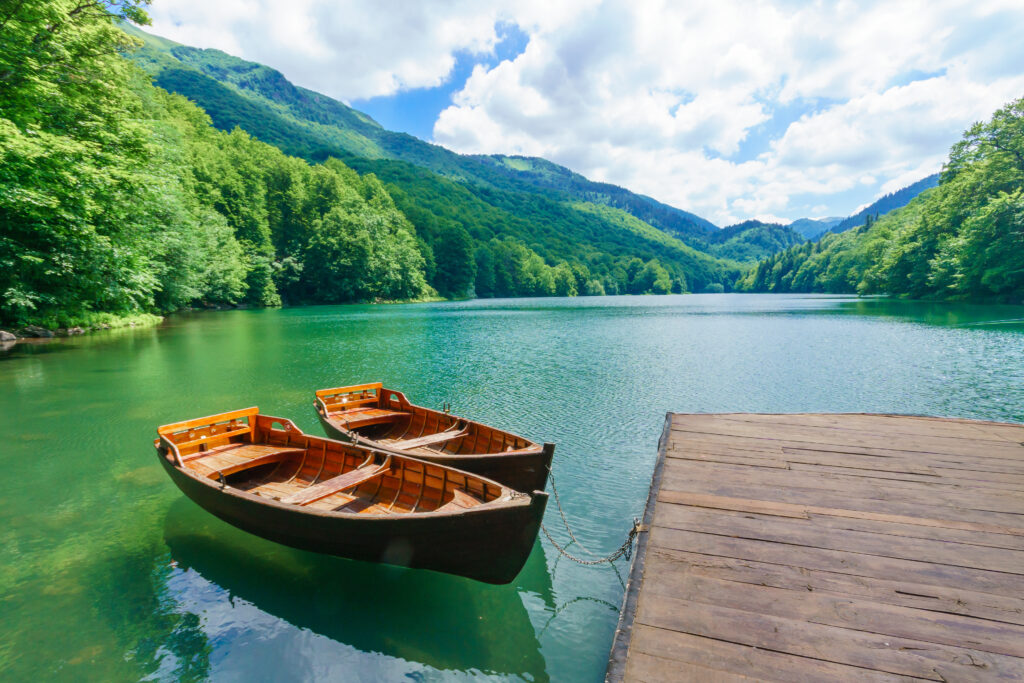
Biogradska Lake (Biogradska jezero)
The largest and most enchanting of the park’s five lakes is Biogradska (altitude 1,094m, length 1,100m, average depth 4.5m), a shimmering body of deep-blue water ringed by thick banks of pine and fir. It’s encircled by a 3km-long pedestrian path, which should take no more than a leisurely hour or so to walk.
There are plenty more activities to participate in, though, with possibilities for cycling and messing about on the water. If you’ve got a few moments to spare, pop your head into the visitor centre’s little exhibition, which mainly concentrates on the park’s flora and fauna, though there’s also an enlightening section on life in a katun.
Cetinje
Nestled in a shallow bowl surrounded by clipped woods and frozen limestone peaks, Cetinje, 670m above sea level and 30km west of Podgorica, is the spiritual heart of Montenegro. Once the royal capital of the country, it also withstood repeated Turkish assaults over the centuries – thus the town exerts a peculiarly romantic hold over many Montenegrins.
Travelling in the 1930s, Canadian journalist Lovatt Edwards described Cetinje as ‘sleepy and undistinguished, a city of pensioners’ – and while this simple mountain town of around 20,000 inhabitants retains a languid, almost timeless air, it certainly offers a pleasing antidote to Podgorica’s faceless modernity.
The town’s wide, tree-lined boulevards might now be somewhat shabby in places, and the pastel-coloured tenements a little flaky, but Cetinje’s once illustrious past is still very much in evidence, thanks to some grand, if timeworn, public buildings and a raft of fin-de-siècle mansions that now accommodate diplomatic residences.
What to see and do in Cetinje
Trg Umjetnosti and around
Dividing up the northern and southern halves of Njegoševa is Trg Umjetnosti, a modest little square in and around which are a number of historically interesting buildings, including several former embassies. On the west side of the square is the former British Embassy, the last of the embassies to be built in Cetinje (1912).
Nearby, on Voyjvode Batrića, is the former Russian Embassy, dating from 1903 and now serving as Montenegro University’s Faculty of Fine Arts. The largest and most flamboyant of all the missions, it’s architecturally reminiscent of St Petersburg, with late Baroque styling by Italian architect Corradini. The nearby former Turkish Embassy is the state school of drama, while the former Bulgarian Embassy is now a restaurant.
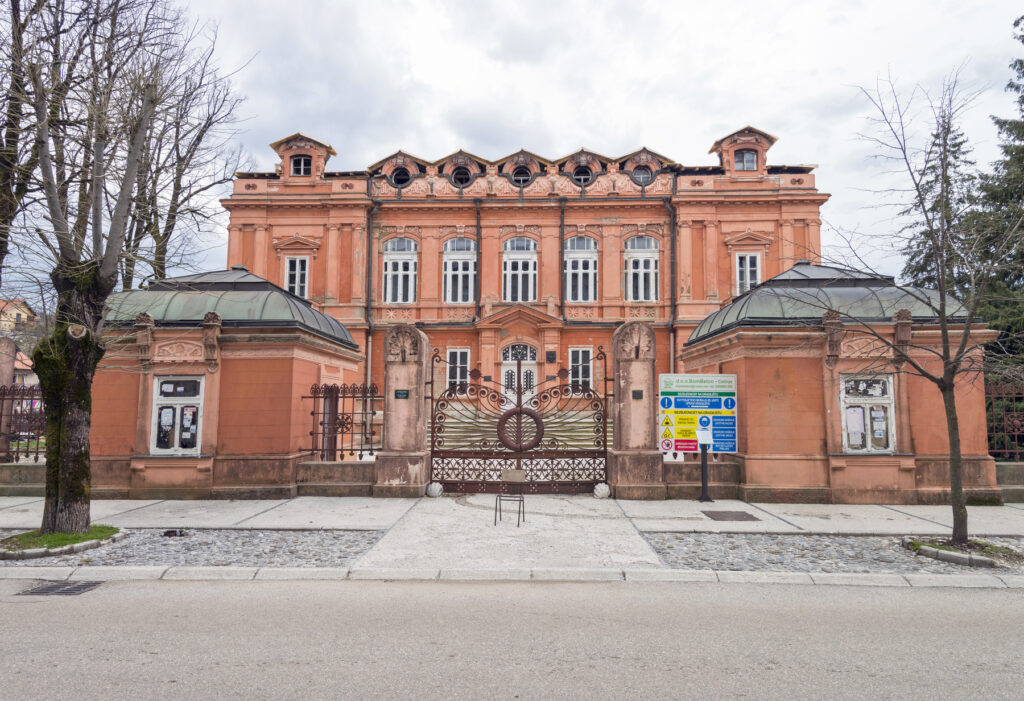
Northeast of Trg Umjetnosti, just beyond the former Turkish embassy on ul Baja Pivljanina, is the smoothly symmetrical bright cream-coloured Zetski Dom Royal Theatre. Constructed piecemeal between 1884 and 1892, it was Montenegro’s first purpose-built theatre, staging the country’s first play, The Balkan Empress – written by Prince Nikola himself – in 1888. Reconstructed in 1931 following a battering by the Austro-Hungarians, it took on its present incarnation in the wake of the 1979 earthquake.
Just 100m further down from the British Embassy stands the stately Blue Palace, built in 1895 for Crown Prince Danilo and so named on account of its colour, though it’s actually more mottle-grey in appearance. Immaculately restored, the palace is now the official residence of the President of Montenegro, though he very rarely visits or stays here.
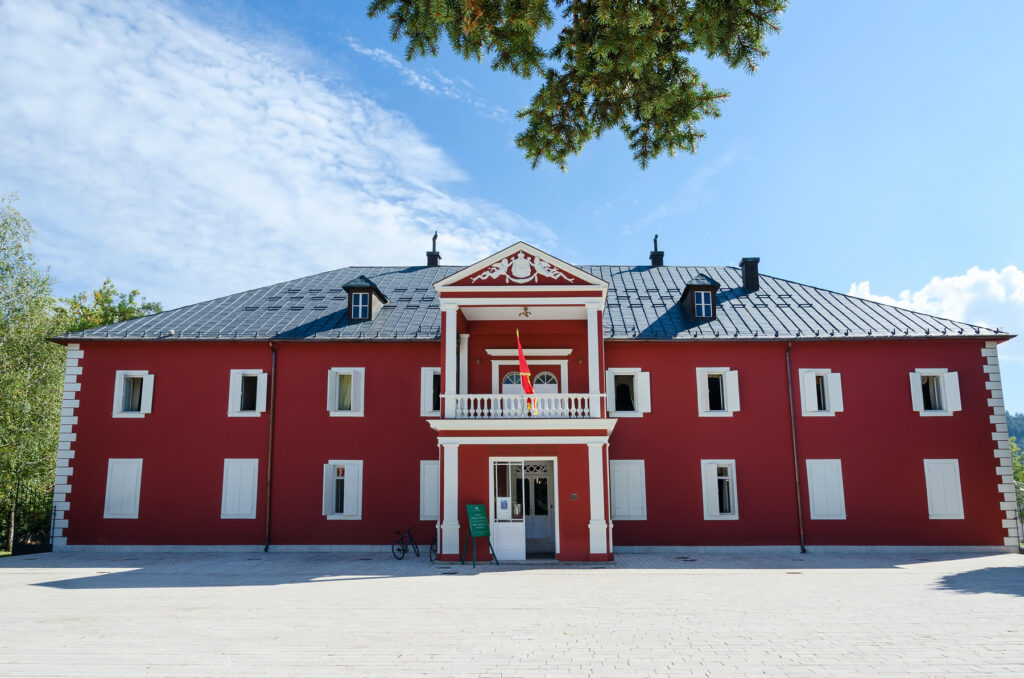
King Nikola’s Museum
Taking centre stage on Trg Dvorski is King Nikola’s Museum (also known as King Nikola’s Palace), a long brown-plastered building that looks more like a lesser 19th-century mansion than the home of Montenegro’s only monarch. The only slight concession to grandeur is an extended porch atop which is a ceremonial balcony. The gilded period of his reign has been beguilingly recreated in salons arranged as they would have been; save for a chair and desk, there’s little remaining of Nikola’s original possessions, as most of it was pillaged during World War II.
In addition, there are now romantic displays of arms, sparkling decorations, and banners including a company standard emotively riddled with bullets from the major 19th-century encounter with the Turks at Vučji Do.
Ethnographic Museum
Probably the most diverting of Cetinje’s museums is the splendid Ethnographic Museum, housed in the beautifully restored former Serbian Embassy diagonally across the square from the Royal Palace. The greater part of the collection comprises a sumptuous assortment of Montenegrin costumes dating from the 19th century; men would typically be attired in a jerkin, a tight-fitting, finely embroidered waistcoat, while women’s traditional costume consisted of a košulja, a frilly cream-coloured blouse, over which a koreta, a long, light-green sleeveless jacket, would usually be worn.
National Museum and Art Gallery (Narodni muzej Crne Gore)
A grandiose edifice completed in 1910, the Government House (Vladin Dom) accommodates the sprawling National Museum and Art Gallery of Montenegro. The ground floor is devoted to Montenegrin history, with a voluminous collection of artefacts spanning the centuries, but predominantly focused on the country’s military affairs. Admirable though this arsenal of trophies is, it’s a trifle repetitive and not helped by the absence of decent English captioning; that said, the display of Turkish battle standards seized at Grahovac (1858) and Vučji dol (1869) – the Turks were comprehensively routed at both – is impressive.
More satisfying is the art collection on the first floor, which offers a thoroughgoing assessment of 19th- and 20th-century work by artists from countries of the former Yugoslavia. Pre-eminent among these was the Croatian sculptor Ivan Meštrović, though the pieces on display here are far from representative of his best work – you’re better off making the trip up to Mount Lovćen to view his immense sculpture of Njegoš’s Mausoleum.
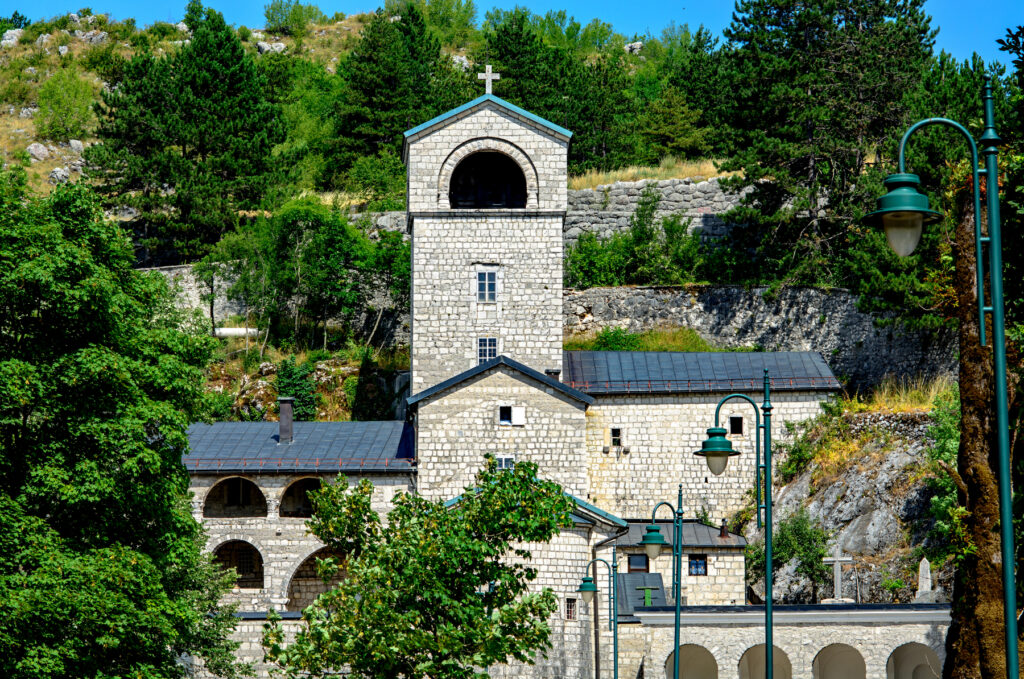
Cetinje Monastery
At the western end of town, sheltering beneath the rock, Cetinje Monastery (Cetinjski Manastir) was completed by the founder of the Njegoš dynasty, Prince-Bishop Danilo in 1701. Part church, part fortress and part munitions store, the monastery building housed a rudimentary administration under the aegis of Danilo and his successors, who fused together the functions of prince and bishop to forge a dynasty of theocratic rulers.
A tiny cruciform chapel, carved from neatly hewn stone, contains the tombs of Prince Danilo and Petar I, the uncle of the celebrated poet king. Its most celebrated, if somewhat macabre, relic is the right hand of St John the Baptist: having endured a rather circuitous route via Constantinople, Malta, Russia and Estonia, the wizened hand (minus two fingers) ended up in the possession of the communists in Serbia after World War II, before being transferred to Cetinje in 1978. It’s held within a glass coffin, and you can ask one of the monks to see it.
Here, too, is the treasury (though frustratingly it’s only open to groups), holding a fine display of 15th- and 19th-century icons and religious books. The most important of these is Oktoih (The First Voice), a gospel dating from 1493; it’s one of the oldest printed books in existence and certainly among the first ever printed in the Slavonic language. Here, too, you’ll find the staff and seal of Ivan Crnojević, metropolitan crowns and mitres bright with jewels, and an intricate ornamental cloth embroidered by Catherine the Great.
Most monasteries produce their own rakija – fruit brandy – and this one is no exception. There are beehives here, too, which interestingly yield honey from the flower of pelen or wormwood, as in absinthe. On a small rise above the monastery is the site of the tablja, a small stone tower built by Petar II in 1835, which was used for impaling Turkish heads on.
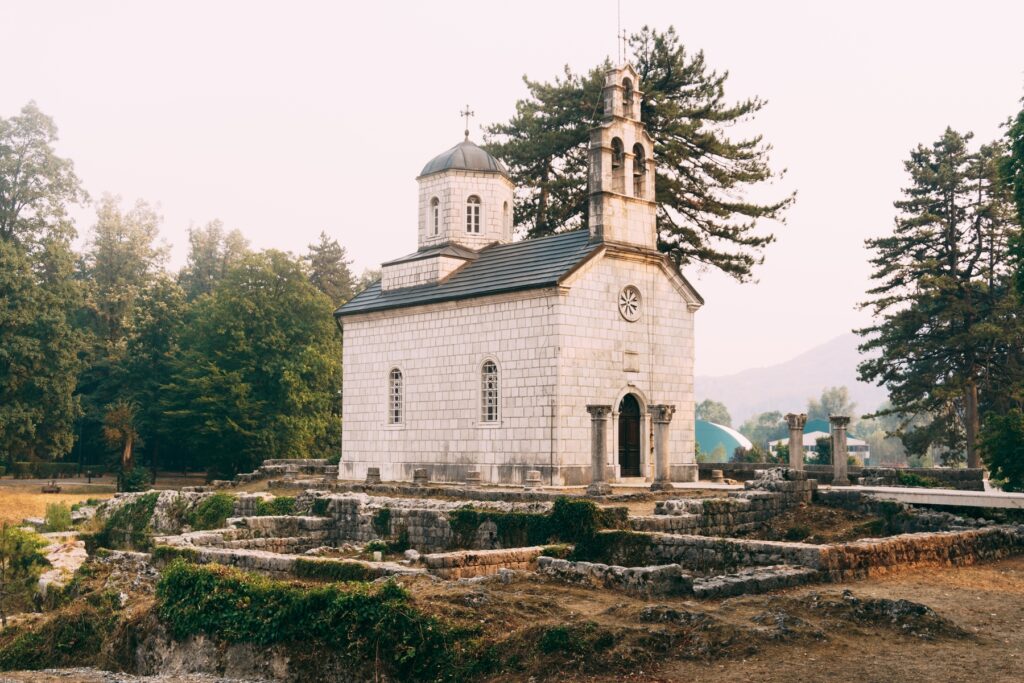
Ćipur Church
Separated by the crocus meadow from the present-day monastery stands a court chapel, which was built in 1886 by Prince Nikola on the foundations of the central church of the original 15th-century Crnojević Monastery. Some remnants of this early monastery are still visible and the place continues to be known quaintly as cipur (derived from the Greek word kipuria meaning ‘vegetable plot’).
Inside the diminutive Church of the Virgin Mary’s Birth at Ćipur, a simple, single-aisled structure, are the gleaming marble tombs containing the remains of King Nikola I and Queen Milena, which were transferred here from the Russian Church in San Remo in 1989 – an event that, for many Montenegrins, symbolised the end of communism.
Durmitor National Park
The almost completely mountainous Durmitor region is inland Montenegro’s siren draw, a spectacularly wild and wonderful region of saw-toothed peaks, glacial lakes, deep canyons and wide alpine pastures.
Designated a national park in 1978 – it’s the largest of the country’s five national parks – and inscribed on the UNESCO World Heritage List in 1980, Durmitor is bordered by the Piva Canyon and plateau to the west, and the Jezera Plateau to the east. In its western section, the park’s boundaries embrace the many peaks of the Durmitor Massif, a great shaft of limestone which numbers nearly 50 peaks that rise higher than 2,000m, 27 of them reaching more than 2,200m; Bobotov kuk is the highest at 2,523m.
The narrow finger that extends to the east incorporates the magnificent Tara River Canyon, whose eponymous river crashes through the heart of the gorge. Etymologically speaking, the name Durmitor is thought to derive from the Celtic drumitor, meaning ’water from the mountain’ which, given the preponderance of lakes within the park – fed by melted snow from the Durmitor Massif – seems wholly apt.
The park harbours a wide range of flora – the high grassland areas in particular are richly carpeted in plant life – and fauna, the mountains sheltering brown bear, grey wolves and chamois, among others, as well as over 150 types of birdlife.
Durmitor’s key resort, and the only settlement of any size in the region, is Žabljak, which though traditionally better known as the country’s main ski centre, is no less busy a place during the summer months when walkers, hikers and adventure sports enthusiasts arrive here in large numbers.
Indeed, Durmitor offers limitless possibilities for outdoor pursuits – in addition to skiing, climbing and hiking, white-water rafting, kayaking and canyoning are increasingly popular on the Tara River. The Tara, richly sourced with trout and char, is also an attractive proposition for anglers during the fishing season, as are some of the mountain lakes.
Kotor & Boka Kotorska
In the furthest recess of the Boka at the very foot of majestic Mt Lovćen lies Kotor:
“In the winter the sea freezes and in the morning the first rays of sun melt the ice, turning the water into a thin layer of very light fog. Boats then seem to sail on the clouds, as if in a painting by the extraordinary Montenegrin artist Vojo (Vojslav) Stanić.”
But Italian writer Nicolò Carnimeo, in Montenegro, A Timeless Voyage, is describing the shortest midwinter days when the sun barely reaches the top of the mountain. In spring or in autumn, the most beautiful seasons throughout Montenegro, the city is held spellbound while the sun slips minute by minute down the jagged face of rock, bathing granite and marble in a honeyed glow. By now Jovan Martinović, archaeologist, polymath and respected citizen of Kotor, is viewing this daily pageant from the sea wall across the bay. Each morning he rises at 04.00 and, carrying his fishing rod, strides west beyond Prčanj.
Behind the mighty 20m ramparts that shield Kotor from the waterfront, the vegetable and fish market, and the harbour bustle, the medieval city is labyrinthine but small enough that it is impossible to be lost – just frequently confused. The streets are mostly unnamed, though a few are known informally. For example, Pusti me da prođem (Let Me Pass Street) which speaks for itself. The city’s irregular squares are known by their original designations: trg od Brašna (Square of Flour), trg od Oružja (Square of Milk), and so on. Cats scuttle everywhere but the absolute monarch is Mićun (‘the Big One’). See him strutting his stuff in front of St Tryphon Cathedral. But do not speak to him: like sentries everywhere he will ignore you.
Kotor is listed by UNESCO as a World Heritage Site.
The Boka Kotorska
The grandest of Montenegro’s deep-blue inlets, the stunning Boka (‘inlet’) Kotorska is renowned for its spectacular scenery and cultural heritage, including the UNESCO-listed old city of Kotor. While its inner bays largely lack real beaches, the Boka holds plenty of potential for divers. And foodies will find here a couple of Montenegro’s best restaurants.
The entire length of the Boka Kotorska is 15 nautical miles or 28km, stretching from Meljine, just east of Herceg Novi, to Kotor. The road, which follows the northern coastline through Bijela, Risan, Perast and Dobrota, covers the same journey in a little over 40km of beautiful scenery.
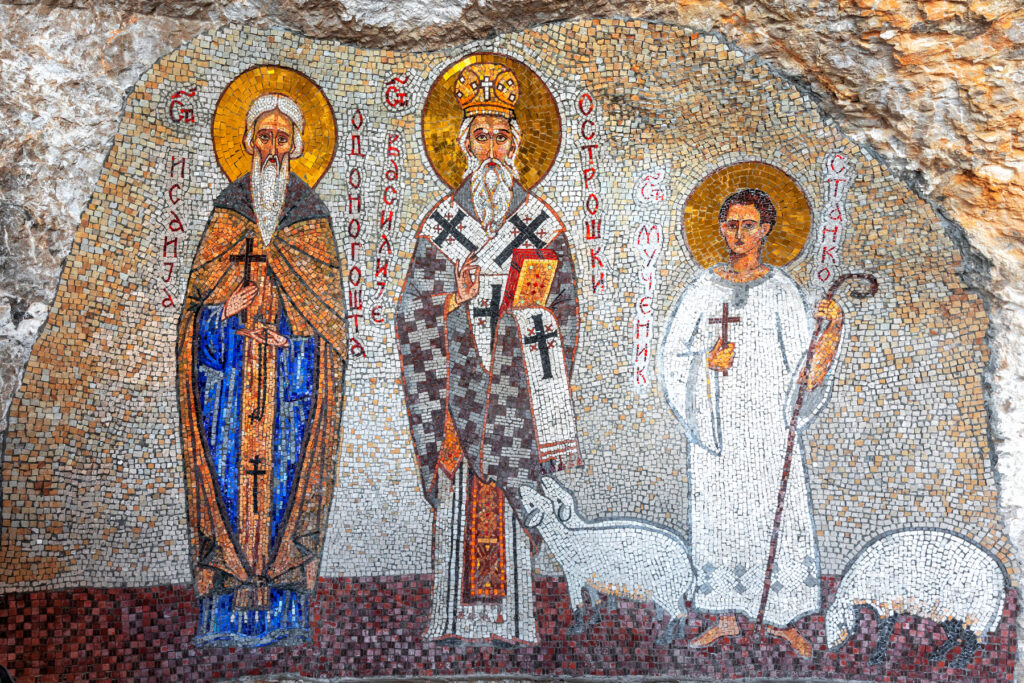
Ostrog Monastery
Several kilometres northwest of Danilovgrad, it’s just about possible to detect a white speck grafted into the grey, vertiginous rock face on the opposite side of the valley. In a setting that is as unforgettable as it is improbable, this is Ostrog Monastery, Montenegro’s most important place of pilgrimage.
Although it’s possible that the monastery’s initial foundations might have been laid by hermits some time earlier, Ostrog was officially founded in the mid 17th century by Vasilije Jovanović, more commonly known as St Basil of Ostrog.
Ostrog actually comprises two complexes, the first of which, the larger lower monastery, is centred around the Church of the Holy Trinity, built in 1824, and is also the location of the majority of the monastic residences, including the modern konak. The white, rock-hewn upper monastery, a tough little 3km walk uphill (but also accessible by car), holds two diminutive cave churches, one of which, the Holy Cross, features some splendid rock-painted frescoes by the great 17th-century Serbian artist Radul, depicting revered saints (including St Sava and one of St Basil), scenes from the life of Christ, and religious holidays.
Nearby, the Church of the Presentation keeps the relics of St Basil. In truth, there’s not an awful lot to see here, but the tight corridors and passageways of the monastery, lined with icons and mosaics, are certainly atmospheric, and on a clear day the views from the small terrace fronting the upper monastery entrance are fabulous. During the summer it’s best to visit as early or as late as possible in the day in order to avoid the inevitable crush of visitors.
Prokletije National Park
Montenegro’s youngest national park – designated as such in 2009 – harbours the glorious Prokletije (Bjeshket e Nemuna in Albanian), a wild and rocky region of deep glacial valleys, sharp cliffs and saw-toothed peaks – it remains one of the most remote and least-visited mountain areas in Europe.
Translated as the ‘Accursed Mountains’ – evocatively brought to life in Robert Carver’s book of the same name – this formidable alpine spine straddles the border with Albania for some 50km, though the Montenegrin share of the Prokletije represents by far the smaller part of the massif. Montenegro’s highest peak, Maja Kolata (2,528m), which trumps Bobotov kuk in Durmitor by just 5m, resides here; Prokletije’s highest peak, Maja Jezerces (2,694m), is on the Albanian side.
Hiking in the Prokletije
There’s fantastic hiking in these mountains, with the best approaches from the Grebaje Valley, a narrow 10km-long glacial valley which begins a short way southwest of Gusinje. Most walks start from the Branko Kotlajić mountain hut located deep inside the valley. A fairly easy half-day hike is up to Volušnica (1,879m), which can be extended (by about 2 hours) to include Popadija on the Albanian border. More challenging, and slightly longer, is the hike to Krošnja (2,165m), from where it’s possible to continue to the needle-sharp peaks of the Karanfili (‘Carnation’; 2,490m), though this latter part is much more difficult and very exposed in places.
A more straightforward but no less beautiful walk is along the adjacent Ropojana Valley: beginning in Vusanje, follow the flat track all the way to the Jezerce Lake which sits in a large basin at the head of the valley, on the other side of which is the Albanian border – this 11km round trip should take no more than 4 hours. For more on walks in this area, consult Rudolf Abraham’s The Mountains of Montenegro and the same author’s Peaks of the Balkans Trail.
To stay at any of the mountain huts, it is important to make arrangements in advance; expect to pay around €5 for a bed per night. Check out Karanfili Huts, Branko Kotlajić Hut or Ropojanski Zastan.
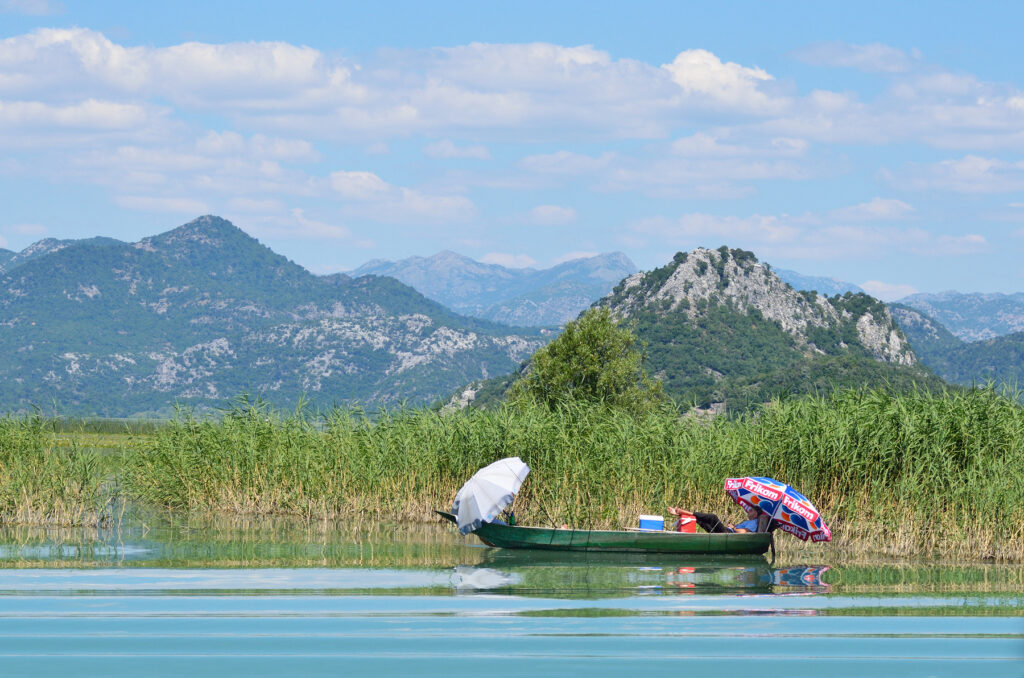
Skadar Lake National Park
Consuming the greater part of Lake Skadar National Park, the second largest of Montenegro’s five designated parks, Lake Skadar (Skadarsko jezero) some 25km south of Podgorica, is the most substantial body of water in the Balkan Peninsula. Bordered to the east by Albania (to which a third of the lake belongs), and enclosed on three sides by bare-topped karst mountains, Lake Skadar maintains an eerie, almost magical presence; timeworn villages and monasteries dot the lakeshore, beneath which shallow blue waters, reflecting the myriad colours of vegetation, shimmer through the thin summer heat-haze.
Some 44km at its longest point, 14km wide, and with an average depth of around 6m, the lake is fed by waters from the Morača River and drains into the Adriatic via the Bojana, which flows along the Albanian border. It’s also supplied with fresh water from numerous springs in the karst floor; known as oko (eyes), these are a result of the fact that part of the lake lies below sea level. The northern and eastern shores, where the lake is shallower than elsewhere, are characterised by large swathes of marshland which, during springtime, burst forth with vegetation of white and yellow water lilies, reed groves and dense clusters of willow.
Here, too, are the lake’s two settlements of note, namely Vranjina, home to the park’s visitor centre, and Virpazar, a small but very busy fishing village with some good accommodation and eating possibilities. In contrast, the western shore is more remote. Studded with rocky islets and sharply indented bays, it’s also home to the lake’s foremost cultural monuments in the shape of several island-bound monasteries.
Lake Skadar National Park is also one of the most important birding sanctuaries in the Balkans. The lake also contains more than 40 species of fish, including abundant stocks of carp, chub, eel and mullet, and its shores are home to a huge variety of other fauna – otters and polecats, to name but two. Vegetation on the lake is plentiful, not least in the form of a rather peculiar local delicacy called kasaronja, a sort of water chestnut that steadfastly refuses to bear fruit in times of drought, despite the unlimited supplies of water of the lake itself.
Ulcinj
The most southerly town on the Montenegrin coast, Ulcinj (Ulqin in Albanian) is immediately different from anywhere to the north. The Venetian influence that is dominant from the northernmost reaches of the coast down to Bar is absent here, and Ulcinj, just 18km shy of the Albanian border, has a marked oriental flavour. This is little surprise given that more than 80% of the population is Albanian – Turkish-style houses huddle around the bay in the cramped Old Town and up in the surrounding hills, and there are no fewer than 26 mosques in town.
What to see and do in Ulcinj
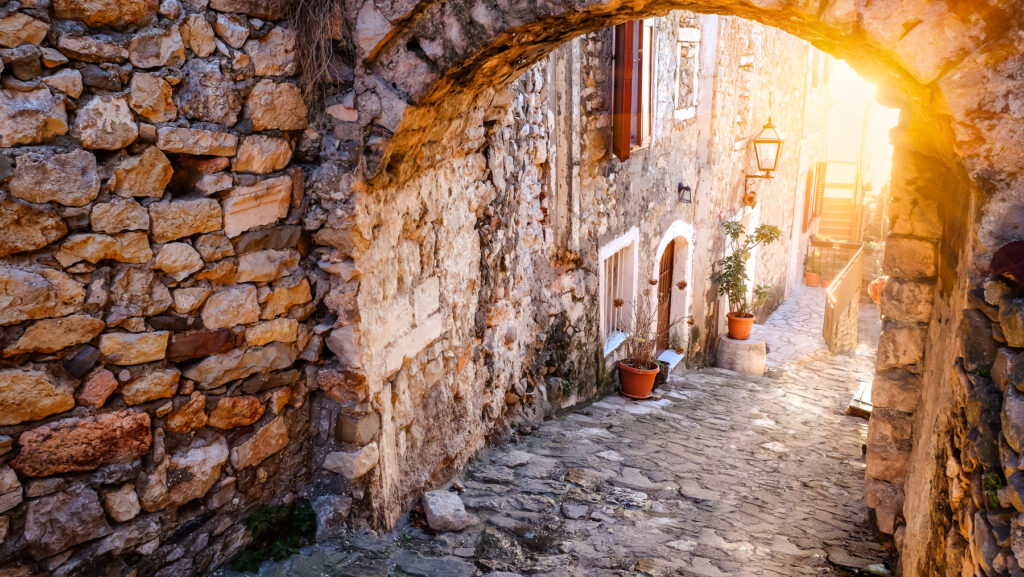
Old Town
Ulcinj today has precious little to show for its ancient history, although the Old Town, sited high up on some cliffs to the southwest of town, retains vestiges of its colourful past. Largely destroyed during the earthquake in 1979, the citadel, embraced within its thick reinforced walls, is for the most part a dilapidated ruin, though there are now a couple of hotels and a clutch of restaurants here.
There is also the very worthwhile Museum of Local History, a small complex of three buildings clustered around the old slave market, often referred to as the Square of Slaves. Before entering, take a peek at a section of wall through the arch beyond the reception desk – these huge stones comprise the oldest remaining section of the original walls dating, incredibly, from 5 BC. The first building, the 14th-century church-mosque, whose minaret was unceremoniously chopped off leaving an enlarged stub, keeps numerous archaeological curios – Illyrian earthenware, Greek and Roman pottery, cathedral pillars and finds from Šas/Svač.
Across the way is the Balšič Tower, a chunky stone edifice that was almost wholly rebuilt following the 1979 earthquake. Its three floors are taken up with an eminently enjoyable photographic exhibition, with photos depicting life in Ulcinj from the late 19th century through to the 1950s. The tower is also notable for the two altars on its top floor, where the 17th-century Jewish dissident and passionate advocate of Talmudic reform, Sabetha Sebi (Sabbatai Cevi), used to come and pray in secret. Housed in the third building is the ethnographic collection, featuring the standard hunting and fishing exhibits and local folk costumes. More interesting are the amphorae and several Turkish displays, notably the mock-up Muslim living room with a sofra, a low circular table around which people would kneel and eat.
Before leaving, have a look inside the ground floor of the museum’s office building (near the entrance), where a maquette illustrates how the citadel looked prior to the earthquake. More curiously, etched into the walls are drawings of boats – the etching just inside the entrance is thought to be some 400 years old – which would indicate that this was once a dwelling place for pirates.
New town
Just to the west of the citadel stands the Cathedral of St Nikola (Catedrala Sv Nikola), a rare concession to the Christian faith hereabouts. Its lawns are carpeted with rows of lovely olive trees. Interestingly, the church was rebuilt as such in 1890, having previously functioned as a mosque. It’s a short walk down from the citadel to the Pasha Mosque (Pažina džamija), designed by Ali Pasha I in 1719 and the only mosque in the country with a working hammam.
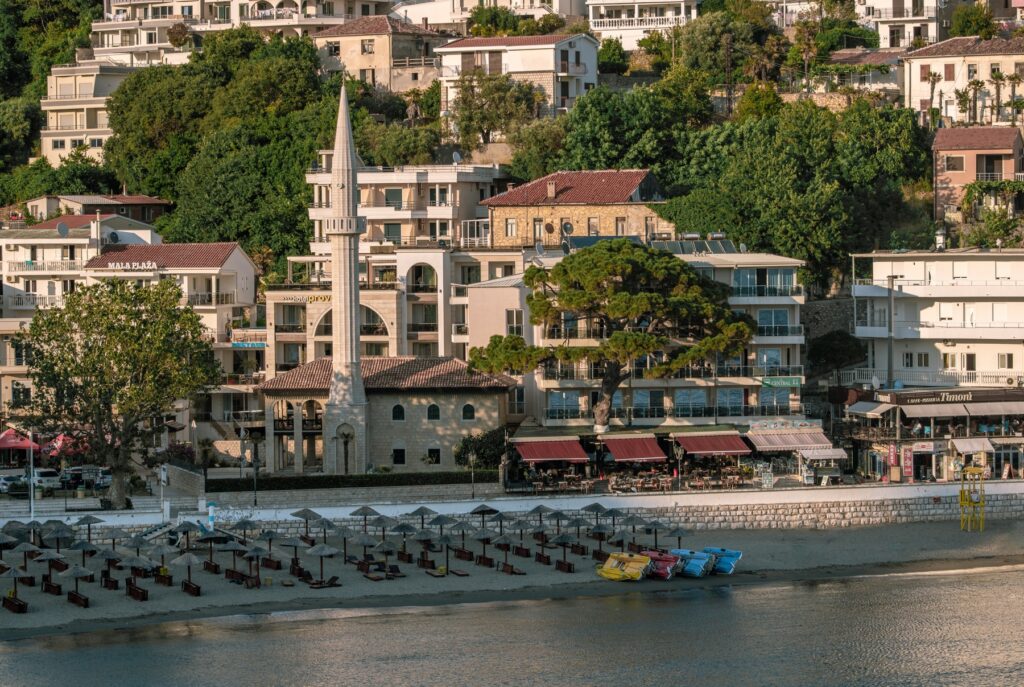
Heading further towards the heart of town, the next mosque you come to is the Namazdjah Mosque (Namazdjah džamija, built in 1828 and complete with a fine-looking clocktower. Beyond here, the Bregut Mosque (Bregut džamija), built by the sea captain Ahmed Djuli in 1783, is the largest of the lot. Note that the minarets here in Ulcinj are conspicuously shorter than elsewhere, the result of reconstruction following damage during the earthquake.
Arcing below the citadel is the gunmetal-grey town beach (Mala Plaža, or ‘Small Beach’), which is pleasant enough but you can’t move for bodies in the summer. For that reason alone you’re better off heading to the vast expanse of the Great Beach (Velika Plaža), south of town.
Related books
For more information, see our guide to Montenegro:
Related articles
There is no better way to see the Montenegrin coast than by car.
